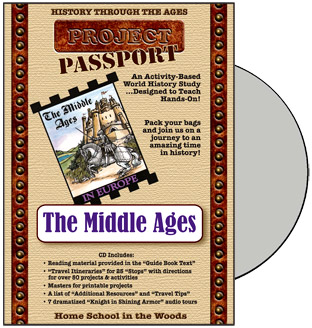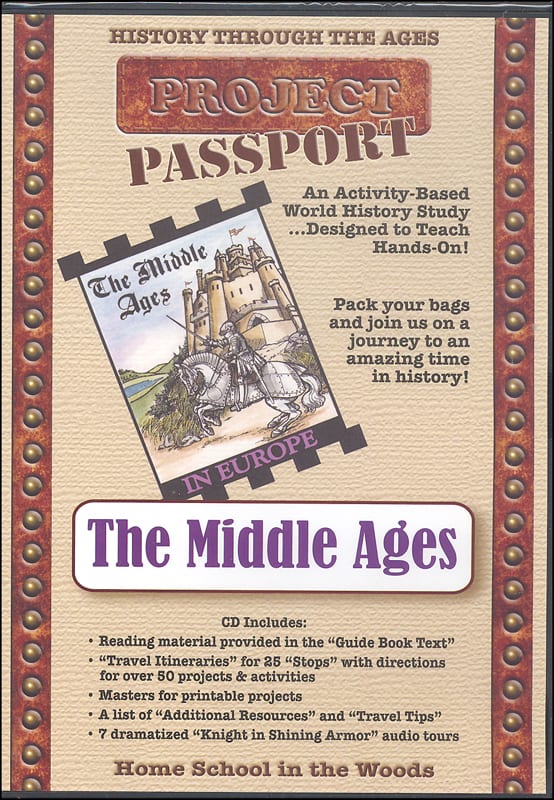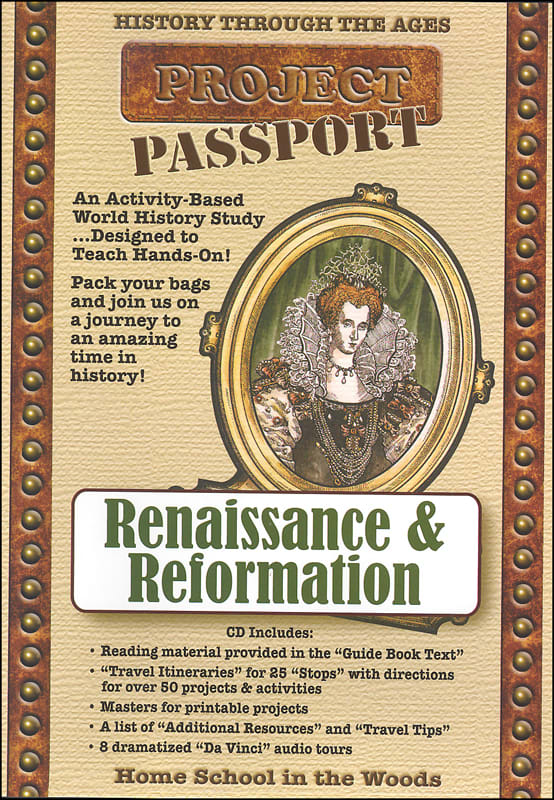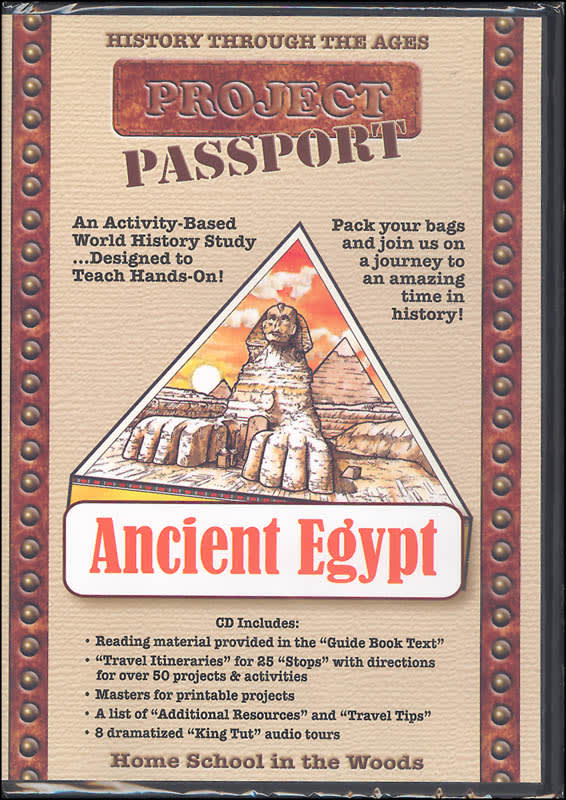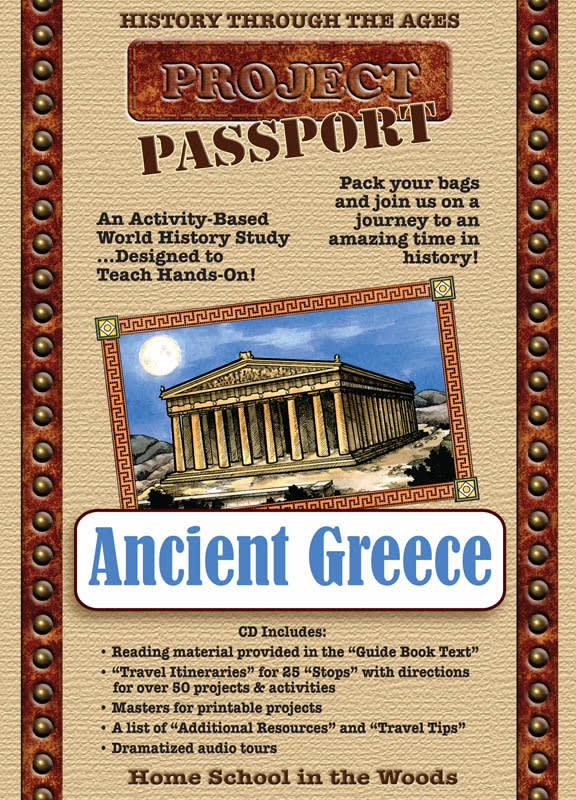Amy Pak covers United States History in her excellent Time Travelers series. Using the same ideas, Amy has created an activity-based series for studying world history with Project Passport. Like Time Travelers, each entire course is presented via PDF files on a CD-ROM that will run on either Windows or Mac systems. Each study can be used with students in grades three through eight, but you will need to select age-appropriate activities for different learners.
Four studies are available in this series thus far: Ancient Egypt, Ancient Greece, The Middle Ages, and Renaissance and Reformation. A Project Passport study might be your complete history course for a year at the younger grade levels, but older students will need to use one or more of these studies in conjunction with either a core text/program or a series of living books. An “Additional Resources” section on each CD-ROM suggests many books and DVDs you might use either to construct a complete course or to use as supplements.
The Middle Ages
I'll begin by describing the The Middle Ages, but other Project Passport studies follow the same format. The Middle Ages follows a traveling theme with “Guide Book Text” and “Travel Itineraries” for each of 25 travel “destinations” or “stops.” Students create their own passport, luggage folder, “Snapshot Moments in History” timeline, and other travel-themed components. Students conclude their travels by creating a travel brochure with their own highlights.
This is an activity-based approach to history with many multi-sensory activities for each section. Students create lapbooks, timelines, and postcards. They play games, create edible projects, and listen to music and “audio tours.” They read the sections of text-like information, do map work, and create newspaper pages on illustrated and formatted pages. Formatted pages are included for the activities including timeline illustrations. While there are lots of cut-and-paste activities, they are creative with shapes, folds, drawing, coloring, and other art work that produces very interesting finished products that children are likely to enjoy creating and showing to others. Activities sometimes require the use of hot glue and an exacto knife, so parental supervision and assistance is mandatory.
Audio tours are audio dramatizations that help students learn more about a particular event or topic. For example, a novice at a monastery escorts a tour group around the monastery grounds. In another audio tour, the tour group’s attempt to travel to Italy is deterred by the Black Plague. The detoured tour group then encounters a group of flagellants who are beating themselves as a sacrificial attempt to atone for sin as well as to call others to repentance that God might spare people from the plague. Audio tours are exceptionally well done with various voice actors and sound effects.
“Travel Tips” let parents know what materials they are going to need, techniques for using them, and general instructions as to how the various components work together. You should read these few pages first.
“Preliminary Packing” PDFs provide the cover title page and spine for a three-ring binder that will serve as the teacher’s Guide Book. Students will prepare a “Scrapbook of Sights” binder in which they will place many of their projects.
The “start” page on the CD makes it very easy to find your way around in Project Passport. From the start page, you can navigate to each step, then to most lesson components with a single click. It would be even better if you could also navigate from the “Travel Itinerary” pages, but that would be asking a lot! While I felt a little lost at first in Time Travelers, I found Project Passport very easy to figure out and navigate—a nice improvement over Time Travelers.
The 25 “stops” in the study generally address themes rather than single events. Among the themes in Middle Ages are barbarians; family; clothing and food; community; crime, punishment, and entertainment; towns and guilds; merchants, trade, and exploration; science and invention; education; the arts; medicine and disease; the church and other religious events; monastic life; the crusades; knights and chivalry; the Vikings; Muslim invasions; conflicts and wars in Eastern Europe; and conflicts and wars in England.
The text-like information for each stop generally goes into some detail on each topic. You will probably want to read these sections aloud with your children, although older students can certainly read them on their own. I think the text might sometimes be a bit too detailed for third and fourth graders, so use your own judgment regarding use of the text material with younger students. In some cases, you might summarize the main idea for them rather than read the entire section.
While there is relatively extensive coverage of church history, the perspective is clearly Protestant in the “Guide Book Text” as well as the descriptive labels on some timeline characters.
Ancient Egypt
The 25 stops on the itinerary for Ancient Egypt include everyday life; agriculture, trade, and transportation; education; literature and writing; the sciences; medicine and disease; Ancient Egyptian arts; the Great Builders; religion and the "gods"; governing the land; the first dynasties; the new kingdom begins; Egypt's most famous woman; the conquering pharaoh; Akhenaton and Tutankhamen; and Ancient Egypt and the Bible. The last stop I listed addresses the present-day controversy over the actual dates of Egyptian dynasties, as well as how well the various dates concur with the biblical chronology.
Examples of some of the craft activities are Make a "Papyrus" Scroll, Make a Cartouche, and Make a Hyksos Chariot. Audio tours include: "Touring Down the Nile," "Interview with an Embalmer," "Visiting a Temple School," "Building a Pyramid," "An Interview with Imhotep," "Hyksos Delays," "A Visit with Akhenaton", and "The Exodus."
A Christian perspective plays subtly in the background through most of the "stops," but it shows up in a specific reference to Abram visiting Egypt, the audio "reenactment" of the Exodus, and the aforementioned discussion of the dating controversy.
Ancient Greece
Ancient Greece is the newest Project Passport study. I have not personally reviewed it. According to the publisher it covers topics such as the "Archaic Period, Greek Government, Athens and Sparta, Everyday Life, Farming, Business, Transportation, Education, Literature, Science, Medicine & Disease, The Arts, Philosophy, Religion (Myths and Heroes), Warfare, The Golden Age, Alexander the Great, The Hellenistic Age, Archaeology, and much more."
Renaissance and Reformation
Among the stops in Renaissance and Reformation are everyday life; Renaissance art; famous artists of the Renaissance; music of the Renaissance; literature, drama, and Shakespeare; science, math, and astronomy; inventions; exploration; the early Reformers; Martin Luther; the Thirty Years' War; Ulrich Zwingli; John Calvin; France and the Wars of Religion; Henry VIII; John Knox; and the Counter-Reformation.
You might have noticed that music and art receive more attention in this Project Passport study than they do in others. In addition to learning about the fine arts, students learn to draw with chalk pastels, and learn other art techniques.
Political history and religious history are inextricable from each other in this era, so much of the history is told in the context of stories about the Reformation and the Counter-Reformation. While the presentation is Protestant, it is much more historically accurate and balanced regarding Protestantism and Catholicism than many other Protestant history resources.
Don't miss the "Mercenary Madness" game at the end of the Guide Book. The game is great for reviewing what students should have learned through their "travels."
Summary
Project Passport offers a very creative approach to the study of history that combines information with a variety of activities—activities to appeal to all different types of learners. Use everything or pick and choose what you wish. Even though you might have to do some extra work to adapt to different age levels, this is a great way to keep your entire family on the same topics for history.
Free sample lessons from each study are available at the publisher’s website so you can check it out before buying.




